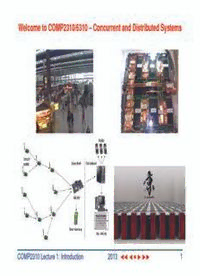
Concurrent and Distributed Systems PDF
Preview Concurrent and Distributed Systems
Welcome to COMP2310/6310 – Concurrent and Distributed Systems ◭◭ ◭ ◮ ◮◮ COMP2310 Lecture 1: Introduction 2013 • × 1 The Growing Importance of Concurrent and Distributed Systems l computer systems are inherently concurrent l computer-based services are inherently distributed l advent of multicore/manycore chips, exascale computing, mobile computing, cloud computing, ubiquitous computing n to what extent must CDS concepts and techniques be treated explicitly in the profession? l followup curriculum in CDS n COMP3300/6330 Operating Systems* n COMP3310/6331 Computer Networks n ˙ COMP3320/6464 High PerfSci. Computation n COMP4330/6430 Parallel Systems* n COMP4330/6433 Real-Time and Embedded Systems* n COMP4340/8320 Multicore Computing* ◭◭ ◭ ◮ ◮◮ COMP2310 Lecture 1: Introduction 2013 • × 2 Course Contact l course web site: http://cs.anu.edu.au/courses/comp2310 l course coordinator & lecturer: Peter Strazdins, CSIT N219, 6125-5140, comp2310@cs l course tutors: Brian Lee, Beau Thompson, and Peter Strazdins (Computer Systems Group) l forums accessible by StReAMS: n Announcements: postings from course staff only n Discussion: for your use (note the rules!) ◭◭ ◭ ◮ ◮◮ COMP2310 Lecture 1: Introduction 2013 • × 3 Course Schedule l lectures: three hours per week l Concurrency: based on Chapters 2–8 and 10 of [Magee&Kramer ] n Processes and Threads, Concurrent Execution, Shared Objects & Interference, Monitors & Condition Synchronization, Deadlock, Safety and Liveness, Model-based Design, Message Passing; Architectures: Operating Systems (+communication) l Distributed Systems: based on Chapters 1–4, 7, 14–18 of [Coulouris&al ] n Overview, Networks, Distributed Time and State, Agreement, Transactions, Replication l . practicals (supervised tutorial/laboratories): 8 (formal) and (3×0 5) informal n → register NOW via http://cs.anu.edu.au/streams n important to come prepared! will contain examinable material! l assignments: 2 l more details on the course schedule page ◭◭ ◭ ◮ ◮◮ COMP2310 Lecture 1: Introduction 2013 • × 4 Course Assessment l see the assessment web page l Assignments: due weeks 7 (18%) and 12 (12%) n note plagiarism issues and unacceptable vs acceptable collaboration: producing a solution with the aid of another’s solution is cheating! working in close groups throughout is dangerous and is unfair to others! l Practical Session Quizzes and Exercises: 10% n best 5 of 2% marks in 8 sessions n note: no extensions! (you should plan to attend all) l Mid-Semester Exam: week 8 (Concurrency) l Final Exam: 50% n 3 hours, 1 page A4 notes (both sides, printed or hand written), no calculator n former exam papers available from course web page; note that not all questions are still applicable ◭◭ ◭ ◮ ◮◮ COMP2310 Lecture 1: Introduction 2013 • × 5 Approach for Concurrent & Distributed Systems l emphasis is on general principles, design (modelling - new!), and systematic implementation n modelling includes Finite State Processes, with structure diagrams BSEMA(Init=0) = BSEMA[Init℄, < > − BSEMA[v:Int℄ = ( when (v Max) up BSEMA[v+1℄ > > | − − when (v 0) down BSEMA[v 1℄ ). l emphasis is on contemporary practice rather than classical theory l CDS are part of our everyday life but reliable computer implementation requires sound understanding of various complex and subtle concepts! l a serious approach is needed for succeeding in this course: n engagement throughout is essential! u especially coming prepared, attending all tutorial / laboratories and completing the (main) exercises u don’t be deceived by the terseness of FSP; it can be subtle and takes time to master! H need to use the ltsatool (& study resulting LTS diagrams) n reading the textbooks, particularly [Magee&Kramer ]) is needed for follow-up ◭◭ ◭ ◮ ◮◮ COMP2310 Lecture 1: Introduction 2013 • × 6 Mastering Concurrent & Distributed Systems l Describe the concepts involved in the construction of CDS. l ‘Speak the language” of concurrent modelling, design and programming. n explain the ideas & issues; explain and analyze key algorithms in CDS n be fluent with 1 modelling language and 2 programming languages l Select appropriate modelling techniques and mechanisms and apply them to the solution of problems in CDS n model problems in FSP and analyze for required properties l Select the appropriate programming language and environment for the task at hand. n understand the strengths and weaknesses of approaches and languages l Write scalable, concurrent modules which show the intended and predictable behaviors. Includes monitors! l Analyze and debug small to medium scale concurrent programs. n design & implement non-trivial solutions in Java and C ◭◭ ◭ ◮ ◮◮ COMP2310 Lecture 1: Introduction 2013 • × 7 Introduction to Concurrency Overview: l what is a concurrent program? l concurrent and distributed software l why concurrent programming? l why is it important to get it right? l (Magee & Kramer’s) Cruise Control System l models and modeling the Cruise Control System l programming practice in Java l objective of the concurrency module; and the book! (the reminder of these slides including graphics are a modified version of the slides from Ch1 of Magee & Kramer: Concurrency) ◭◭ ◭ ◮ ◮◮ COMP2310 Lecture 1: Introduction 2013 • × 8 What is a Concurrent Program? l a sequential program has a single thread of control. l a concurrent program has multiple threads of control allowing it to: n perform multiple computations in parallel n to control multiple external activities which occur at the same time The proper co-ordination of these threads and maintaining the integrity of shared data form the major challenges of concurrent programming! ◭◭ ◭ ◮ ◮◮ COMP2310 Lecture 1: Introduction 2013 • × 9 Concurrent and Distributed Software l interacting, concurrent software components of a system: l single machine → shared memory interactions n programming model: threads API or message passing l multiple machines → network interactions n programming model: message passing (or derivatives, e.g. remote method invocation) n forms a distributed system ◭◭ ◭ ◮ ◮◮ COMP2310 Lecture 1: Introduction 2013 • × 10
